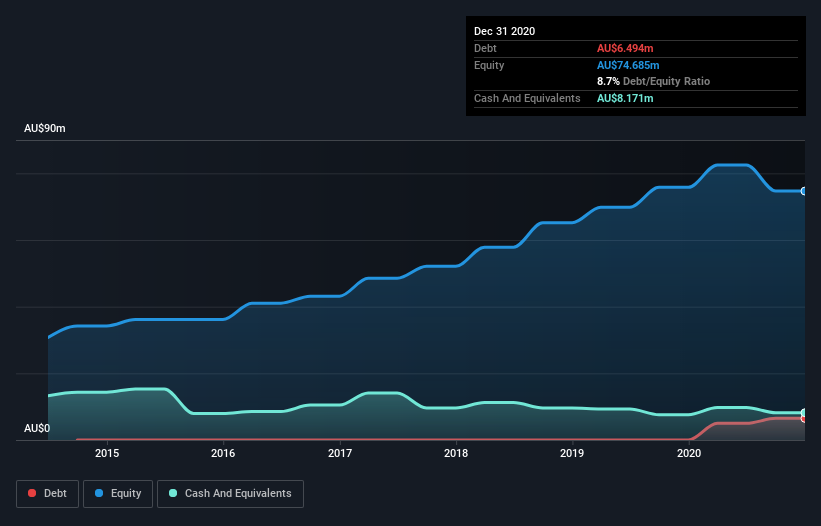Integrated Research (ASX:IRI) Seems To Use Debt Quite Sensibly
The external fund manager backed by Berkshire Hathaway's Charlie Munger, Li Lu, makes no bones about it when he says 'The biggest investment risk is not the volatility of prices, but whether you will suffer a permanent loss of capital.' So it seems the smart money knows that debt - which is usually involved in bankruptcies - is a very important factor, when you assess how risky a company is. We can see that Integrated Research Limited (ASX:IRI) does use debt in its business. But is this debt a concern to shareholders?
What Risk Does Debt Bring?
Debt and other liabilities become risky for a business when it cannot easily fulfill those obligations, either with free cash flow or by raising capital at an attractive price. Part and parcel of capitalism is the process of 'creative destruction' where failed businesses are mercilessly liquidated by their bankers. However, a more common (but still painful) scenario is that it has to raise new equity capital at a low price, thus permanently diluting shareholders. Of course, the upside of debt is that it often represents cheap capital, especially when it replaces dilution in a company with the ability to reinvest at high rates of return. The first thing to do when considering how much debt a business uses is to look at its cash and debt together.
See our latest analysis for Integrated Research
How Much Debt Does Integrated Research Carry?
As you can see below, at the end of December 2020, Integrated Research had AU$6.49m of debt, up from none a year ago. Click the image for more detail. However, it does have AU$8.17m in cash offsetting this, leading to net cash of AU$1.68m.

How Healthy Is Integrated Research's Balance Sheet?
Zooming in on the latest balance sheet data, we can see that Integrated Research had liabilities of AU$30.5m due within 12 months and liabilities of AU$20.1m due beyond that. Offsetting these obligations, it had cash of AU$8.17m as well as receivables valued at AU$45.5m due within 12 months. So it can boast AU$3.06m more liquid assets than total liabilities.
Having regard to Integrated Research's size, it seems that its liquid assets are well balanced with its total liabilities. So while it's hard to imagine that the AU$437.4m company is struggling for cash, we still think it's worth monitoring its balance sheet. Simply put, the fact that Integrated Research has more cash than debt is arguably a good indication that it can manage its debt safely.
It is just as well that Integrated Research's load is not too heavy, because its EBIT was down 32% over the last year. When a company sees its earnings tank, it can sometimes find its relationships with its lenders turn sour. The balance sheet is clearly the area to focus on when you are analysing debt. But ultimately the future profitability of the business will decide if Integrated Research can strengthen its balance sheet over time. So if you're focused on the future you can check out this free report showing analyst profit forecasts.
Finally, a company can only pay off debt with cold hard cash, not accounting profits. Integrated Research may have net cash on the balance sheet, but it is still interesting to look at how well the business converts its earnings before interest and tax (EBIT) to free cash flow, because that will influence both its need for, and its capacity to manage debt. Looking at the most recent three years, Integrated Research recorded free cash flow of 41% of its EBIT, which is weaker than we'd expect. That weak cash conversion makes it more difficult to handle indebtedness.
Summing up
While we empathize with investors who find debt concerning, you should keep in mind that Integrated Research has net cash of AU$1.68m, as well as more liquid assets than liabilities. So we are not troubled with Integrated Research's debt use. When analysing debt levels, the balance sheet is the obvious place to start. However, not all investment risk resides within the balance sheet - far from it. These risks can be hard to spot. Every company has them, and we've spotted 1 warning sign for Integrated Research you should know about.
Of course, if you're the type of investor who prefers buying stocks without the burden of debt, then don't hesitate to discover our exclusive list of net cash growth stocks, today.
If you’re looking to trade Integrated Research, open an account with the lowest-cost* platform trusted by professionals, Interactive Brokers. Their clients from over 200 countries and territories trade stocks, options, futures, forex, bonds and funds worldwide from a single integrated account. Promoted
New: AI Stock Screener & Alerts
Our new AI Stock Screener scans the market every day to uncover opportunities.
• Dividend Powerhouses (3%+ Yield)
• Undervalued Small Caps with Insider Buying
• High growth Tech and AI Companies
Or build your own from over 50 metrics.
This article by Simply Wall St is general in nature. It does not constitute a recommendation to buy or sell any stock, and does not take account of your objectives, or your financial situation. We aim to bring you long-term focused analysis driven by fundamental data. Note that our analysis may not factor in the latest price-sensitive company announcements or qualitative material. Simply Wall St has no position in any stocks mentioned.
*Interactive Brokers Rated Lowest Cost Broker by StockBrokers.com Annual Online Review 2020
Have feedback on this article? Concerned about the content? Get in touch with us directly. Alternatively, email editorial-team (at) simplywallst.com.
About ASX:IRI
Integrated Research
Designs, develops, implements, and sells software for business-critical computing, unified communication, and payment networks.
Flawless balance sheet and undervalued.
Similar Companies
Market Insights
Community Narratives




